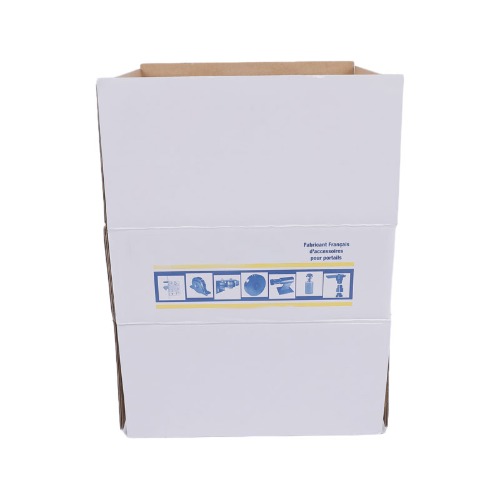The production steps of Carton Packaging Box and The Use of Carton Packaging Box
2023.06.14
The production of carton packaging boxes involves several steps from design to the final product. Here is a general overview of the production process:
Design and Prepress: The process starts with the design of the packaging box. Designers create the structural layout, graphics, and artwork using specialized software. Once the design is finalized, it goes through prepress, where it is prepared for printing. This involves color separation, proofing, and creating printing plates.
Material Selection: The appropriate type and grade of carton material are selected based on the specific requirements of the packaging. Common carton materials include corrugated board, solid board, and folding carton board. The material selection depends on factors such as product weight, protection needed, and printing capabilities.
Printing: The selected design is printed onto the carton material using printing presses. Depending on the complexity and requirements of the design, different printing techniques like flexography, lithography, or digital printing may be used. This step applies the desired graphics, colors, branding, and product information onto the carton.
Die Cutting: After printing, the carton sheets are fed into a die-cutting machine. The die-cutting process cuts the printed sheets into the desired shape and size, creating the individual carton blanks. The die-cutting machine uses sharp steel blades or laser technology to cut through the carton material while following the predefined structural layout.
Folding and Gluing: The die-cut carton blanks then move to the folding and gluing stage. Machines fold the carton blanks along pre-scored lines, forming the basic structure of the box. Adhesive is applied to the appropriate areas, and the carton is carefully folded and pressed together, ensuring proper alignment and bonding. This step creates the final shape and structure of the packaging box.
Quality Control: Throughout the production process, quality control checks are conducted to ensure the accuracy of printing, die-cutting, folding, and gluing. Inspections are performed to verify color consistency, registration, structural integrity, and overall appearance. Defective boxes are identified and removed from the production line.
Finishing: Once the boxes are folded and glued, additional finishing processes may be applied as required. This can include adding special coatings or finishes such as gloss or matte varnishes, embossing, debossing, foiling, or spot UV coatings. These finishing techniques enhance the visual appeal, durability, and functionality of the packaging box.
Packaging and Shipping: The finished carton packaging boxes are stacked, packed, and prepared for shipping. They are usually bundled together, palletized, and labeled for easy identification and transportation. The boxes are then shipped to the intended destination, ready to be used for packaging various products.
Besides,Carton packaging boxes are widely used in various industries for packaging and transporting products. Here are some common uses of carton packaging boxes:
Product Packaging: Carton boxes are commonly used for packaging a wide range of products, including consumer goods, electronics, cosmetics, food and beverages, pharmaceuticals, and more. They provide protection, containment, and branding for the products during storage, transportation, and display.
Shipping and Transportation: Carton packaging boxes are essential for shipping and transporting products safely and securely. They provide a sturdy and protective outer shell that helps prevent damage, breakage, and tampering during handling and transit. Carton boxes are designed to withstand stacking, compression, and other stresses encountered in the supply chain.
Retail Packaging: Carton boxes are used for retail packaging, where they serve as both protective containers and marketing tools. Retail packaging boxes often feature attractive graphics, branding, and product information to catch the consumer's attention and enhance the product's presentation on store shelves.
E-commerce Packaging: With the rise of e-commerce, carton packaging boxes have become crucial for packaging products ordered online. These boxes are designed to accommodate different product sizes and shapes, ensuring secure and efficient delivery to customers' doorsteps. E-commerce packaging often includes features like easy opening, tamper-evident seals, and custom inserts for added protection.
Storage and Organization: Carton boxes are useful for storage and organization purposes in homes, offices, and warehouses. They provide a convenient way to store items, keep them organized, and protect them from dust, dirt, and damage. Carton boxes of various sizes and shapes can be utilized for different storage needs, from documents and files to clothing, toys, and household items.
Display and Point of Sale: Carton packaging boxes can be designed to function as display units or point-of-sale stands. They are used in retail environments to showcase products attractively and draw attention to specific promotions or new arrivals. These boxes can be customized with eye-catching graphics, product information, and interactive elements to enhance the visual appeal and drive sales.
Gift Packaging: Carton packaging boxes are commonly used for gift packaging. They provide an elegant and presentable way to present gifts for various occasions such as birthdays, holidays, weddings, and corporate events. Gift boxes often feature decorative elements, ribbon ties, and personalized messages to add a touch of customization and enhance the gifting experience.
Recycling and Sustainability: Carton packaging boxes are recyclable and often made from renewable resources. Their use promotes sustainability and eco-friendly practices. Many carton boxes are manufactured from recycled materials, and the recycling process allows for the reuse of the cardboard fibers, contributing to a circular economy.
Carton packaging boxes are versatile, cost-effective, and widely accepted as a reliable packaging solution across industries. Their use ensures product integrity, convenience in handling and storage, and enhances the overall customer experience.



 English
English  العربية
العربية











